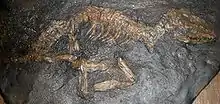| Proviverridae Temporal range: Early to Late Eocene | |
|---|---|
 | |
| Fossil of Lesmesodon edingeri | |
 | |
| Skull of Proviverra typica | |
| Scientific classification | |
| Domain: | Eukaryota |
| Kingdom: | Animalia |
| Phylum: | Chordata |
| Class: | Mammalia |
| Order: | †Hyaenodonta |
| Superfamily: | †Hyaenodontoidea |
| Family: | †Proviverridae Schlosser, 1886[1] |
| Type genus | |
| †Proviverra Rütimeyer, 1862 | |
| Genera | |
| |
| Synonyms | |
Proviverridae ("before civets") is an extinct family of placental mammals from extinct superfamily Hyaenodontoidea within extinct order Hyaenodonta. Fossil remains of these mammals are known from early to late Eocene deposits in Europe.[6][7][8]
Classification and phylogeny
Taxonomy
- Subamily: †Proviverrinae (Wortman, 1902)
- Genus: †Minimovellentodon (Solé, 2014)
- †Minimovellentodon russelli (Solé, 2014)
- Genus: †Morlodon (Solé, 2013)
- †Morlodon vellerei (Solé, 2013)
- Genus: †Parvagula (Lange-Badré, 1987)
- †Parvagula palulae (Lange-Badré, 1987)
- Genus: †Allopterodon (Ginsburg, 1977)
- †Allopterodon bulbosus (Lange-Badré, 1979)
- †Allopterodon minor (Filhol, 1877)
- †Allopterodon torvidus (Van Valen, 1965)
- Genus: †Lesmesodon (Morlo & Habersetzer, 1999)
- †Lesmesodon behnkeae (Morlo & Habersetzer, 1999)
- †Lesmesodon edingeri (Springhorn, 1982)
- †Lesmesodon gunnelli (Solé, 2021)
- Genus: †Proviverra (Rütimeyer, 1862)
- †Proviverra typica (Rütimeyer, 1862)
- Genus: †Minimovellentodon (Solé, 2014)
References
- ↑ Schlosser, M. (1886.) "Paläontologische Notizen. Über das Verhältnis der Cope’schen Creodonta zu den übrigen Fleischfressern." Morphologische Jahrbuch 12: 287–294.
- ↑ Haeckel, Ernst (1895). Systematische Phylogenie: Wirbelthiere (in German). Vol. T.3. Berlin: G. Reimer.
- ↑ W. D. Matthew (1909.) "The Carnivora and Insectivora of the Bridger Basin, middle Eocene." Memoirs of the American Museum of Natural History 9:289-567
- ↑ Van Valen, Leigh (1965). "Some European Proviverrini (Mammalia, Deltatheridia)" (PDF). Palaeontology. 8: 638–665.
- ↑ Trouessart, E. L. (1885.) "Note sur le classification des Analgésiens et diagnoses d'espèces et de genres nouveaux." Bulletin de la Société d'études scientifiques d'Angers, 14, 46–89. [Publ. February, 1885. for year 1884.]
- ↑ McKenna, Malcolm C.; Bell, Susan K. (1997). Classification of Mammals Above the Species Level. New York: Columbia University Press. ISBN 978-0-231-11012-9. Retrieved 16 March 2015.
- ↑ Floréal Solé (2013). "New proviverrine genus from the Early Eocene of Europe and the first phylogeny of Late Palaeocene–Middle Eocene hyaenodontidans (Mammalia)". Journal of Systematic Palaeontology. 11 (4): 375–398. doi:10.1080/14772019.2012.686927. S2CID 84734979.
- ↑ Floréal Solé; Jocelyn Falconnet; Laurent Yves (2014). "New proviverrines (Hyaenodontida) from the early Eocene of Europe; phylogeny and ecological evolution of the Proviverrinae". Zoological Journal of the Linnean Society. 171 (4): 878–917. doi:10.1111/zoj.12155.
This article is issued from Wikipedia. The text is licensed under Creative Commons - Attribution - Sharealike. Additional terms may apply for the media files.